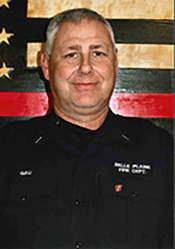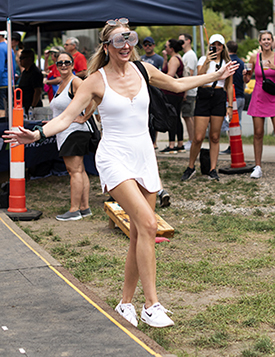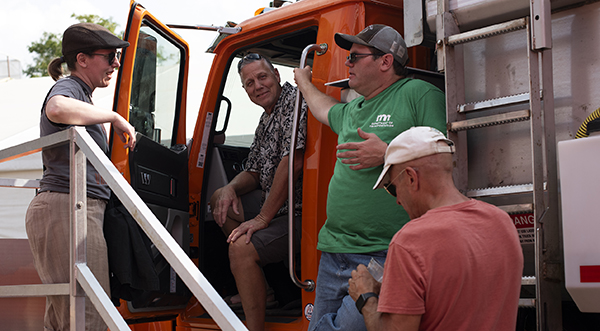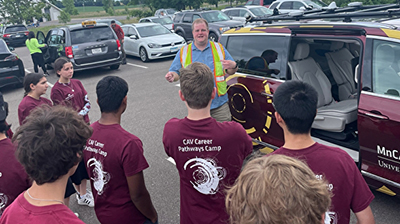 |
|

|
 |
TABLE of CONTENTS
 |
Michael Gau fatally struck by truck in work zone incident |
By Doug Mack

Michael Gau was an inspector on the Golden Valley Central Construction team in Metro District and a longtime volunteer and lieutenant with the Belle Plaine Fire Department. Submitted photo |
Michael Gau, an inspector on the Golden Valley Central Construction team in Metro District, was hit by a truck and killed in a work zone incident on the Rockford Rd/Hwy 169 project in Plymouth on the evening of Aug. 30. He was 54 years old.
“I’m heartbroken by Michael’s death and this tragic incident,” said Commissioner Nancy Daubenberger. “The entire agency joins his coworkers and family as they mourn his passing.”
“Mike will be deeply missed. He worked everyday with a smile on his face and was always making people laugh. He was a hard worker, great firefighter, dedicated to his family, and a friend to many in our office and others around the department,” said Tim Nelson, resident engineer, Golden Valley Central Construction Office. “There is no doubt in my mind that Mike had an impact on everyone that he met.”
Gau had worked at MnDOT for 14 years, in both maintenance and construction. He started as a transportation associate in Eden Prairie maintenance and later was promoted to transportation generalist. He worked in both Shakopee and Chaska before starting in Golden Valley in December 2022.
Gau leaves behind his wife, Jenny; three children, Andrew, Paige and Dalton; and six grandchildren. Outside his work at MnDOT, Gau was a longtime volunteer and lieutenant with the Belle Plaine Fire Department and was named the Belle Plaine Fire Department Firefighter of the Year in 2005. He also enjoyed fishing, hunting, riding his Harley, golfing, umpiring and playing softball.
MnDOT staff are working closely with Minnesota Occupational Safety and Health Administration, the Plymouth Police Department and the Minnesota State Patrol to ensure a full and thorough investigation of the accident.
“This is an extremely difficult time and we know it is challenging to focus on work as we remember Michael’s life and service to Minnesota,” Daubenberger said. “Please give yourself and other colleagues grace, time and space to grieve and take care of yourself in the days ahead.”
Commissioner Daubenberger announced that MnDOT will observe a minute of silence to honor Gau at 11 a.m. on Thursday, Sept. 7. All MnDOT employees are encouraged to safely stop their work and remember Gau's work and service to his community.
Resources are available to employees and their families 24/7 through the Employee Assistance Program:
- For free, confidential help and support, reach a counselor at any time by calling 651-259-3840 or 1-800-657-3719, or by texting “Hello” to 61295.
- The State of Minnesota EAP offers counseling sessions with culturally sensitive counselors, as well as specialists for law enforcement and first responders.
Visitation for Gau will be held on Friday, Sept. 8, from 4 to 8 p.m. at Kolden Funeral Home in Belle Plaine, with a Firemen's Prayer at 7:30 p.m. A Fireman's Tribute and Celebration will be held on Saturday, Sept. 9, at 11 a.m. at Oak Crest Elementary School in Belle Plaine. Visitation will continue at the school that morning from 10 to 11 a.m.
A fund for the family has been established at First National Bank in Belle Plaine. Donations can be made at the bank under the Project Safe Neighborhood account; note “In Honor of Lt. Gau” on the donation.
Donation checks can be mailed to:
First National Bank Minnesota
201 W. Main Street
Belle Plaine, MN 56011-1615 |
| |
|

|
 |
TABLE of CONTENTS
 |
Evolving workplace leads to updated policies for all employees |
By Doug Mack

Agency leadership is evaluating workplace and workforce needs for all facilities statewide.
Photo by Rich Kemp
|
The last few years have seen many changes in how and where employees work. In response to these shifts, MnDOT leadership continues to plan for the future as offices and teams across the agency transition to more permanent work schedules and flexible work environments. MnDOT recognizes many employees have reported to the workplace throughout COVID-19, and will continue to, because of their job responsibilities. As we move into the future, leadership is taking a holistic approach to evaluate workplace and workforce needs.
Planning for the future of the workplace is known as MnDOT’s Evolving Vision and Opportunity (EVO). This initiative has been underway since spring of 2022 and continues to give careful consideration to the needs of all employees while balancing enterprise, agency, district and office priorities, as well as business needs and employees’ personal preferences. Most recently, EVO has worked with leadership to update policies for MnDOT employees.
Details of the updated policies were included in a Notemailer emailed to all employees on Aug. 21. They are also available on iHub. The Minnesota Management and Budget Telework Policy HR/LR #1422 and the MnDOT Telework Policy allow employees the option to telework based on the employee’s job duties, work performance, and MnDOT’s business needs. MnDOT’s Telework Procedures provide details to assist employees and supervisors in following the telework policy and procedures.
Some key points of these new and updated policies include the following:
Requirements for reporting in-person
Beginning in October 2023, all employees will be required to report in-person (to an office, field, lab, or other location associated with their job) a minimum of one day per month. Supervisors and managers will communicate the expectation to their employees.
Although one day per month is the minimum requirement, supervisors and managers may require employees to report to an office or work location on a more frequent basis if business needs exist. A supervisor’s or manager’s personal preference for in-person attendance of employees is not considered a business need.
As much as possible, managers and supervisors should plan to be available on those days where team members are reporting in-person and plan intentional activities for staff, such as team building, training or collaboration, etc.) during the core hours employees are present.
Telework arrangement
Employees and supervisors should work together to assess workplace flexibility options.
Supervisors should use the MnDOT Telework Consideration Form to assess proposed telework schedules for their employees and teams. All telework arrangements, including changes, must follow the Telework Procedures.
Telework schedule and acknowledgment forms
MMB is requiring all employees to complete a new Telework Schedule and Acknowledgement form by October 1, 2023.
Important note: MnDOT is creating a new electronic form (rather than using the existing SmartSheet solution that was required in August 2022) and anticipates this new form will be ready to launch mid-September 2023. Until that time, supervisors and managers should have discussions with their teams about their office or district’s business needs for in-person reporting.
Space planning
Long-term use planning is underway for facilities across the agency, including assigned and hoteling workspaces.
The Department of Administration required all agencies to submit a space plan for buildings within the Capitol Complex and has provided specific standards for all facilities statewide. MnDOT estimates it will take approximately one year for the agency to develop a strategic plan for maximizing its space both at Central Office and districts and special service sites. The plan development will take approximately one year to complete.
While this planning is underway, the agency will undertake parallel efforts to collect information from MnDOT facilities across the state (including district offices, truck stations, special service sites and so on) for planning purposes.
The Department of Administration’s established enterprise standards are primarily focused on workspaces. In keeping with the Department of Administration standards, employees who primarily work onsite may have an assigned workspace at their MnDOT location. MnDOT employees who primarily telework may have access to a variety of shared hoteling workspaces. Examples include hoteling workstations and offices, touchdown spaces, collaboration spaces, conference/meeting rooms, quiet/focus areas, and casual/soft seating. We plan to revisit telework schedules in early 2024 to determine how preferences and/or business needs are changing the space needs within your office or district. Because of this, we are planning to complete strategic space plans by the end of FY24 and begin implementation of proposed space changes afterward. Space planning will continue to evolve as planning efforts continue.
“We are committed to looking at MnDOT’s work environment holistically to take into consideration not just space, but also technology and the needs of our biggest asset, the people,” said Cori Calhoun, assistant division director, Workforce & Agency Services and EVO project manager. “And we’ll do it together.”
Stay informed
The EVO team will continue to provide updates as more details and plans are available. For questions related to telework (including out-of-state telework), email Labor Relations. To provide feedback or suggestions on space planning or other EVO efforts, use the EVO feedback form. Visit the EVO website to learn more about EVO project goals and find resources for working onsite and for teleworking. |
| |
|

|
 |
TABLE of CONTENTS
 |
State Fair booth attracts visitors with plow, goggles and giveaways |

A visitor to the MnDOT booth tries out the “drunk googles” – and finds them disorienting. Photo by Rich Kemp
|
By Anne Meyer
It was another successful State Fair for MnDOT, as thousands of visitors visited the agency’s booth during the twelve-day run, which ended on Monday, Sept. 4. More than 100 employees from across the state volunteered at the booth, answering questions, taking photos of visitors in the cab of the snowplow Plow Bunyan and discussing the agency’s work.
In addition to the plow, the booth featured a selfie wall with road signs, giveaways of state highway maps and ice scrapers, and goggles that simulated different levels of inebriation, which visitors could wear while attempting to walk down a wooden “road” or playing a beanbag-toss game.
“There’s no place like the Great Minnesota Get-Together to engage with and talk to thousands of people,” said Jake Loesch, Director of Communications and Public Engagement. “It’s important for all Minnesotans to have the opportunity to learn about our agency and share their thoughts and feedback, and we’re especially grateful to all MnDOT staff who worked a shift and helped represent MnDOT at the State Fair this year!”

State Fair visitors check out the cab of Plow Bunyan and chat with a MnDOT employee at the MnDOT Booth. Photo by Rich Kemp
|
|
| |
|

|
 |
TABLE of CONTENTS
|
Transportation Leaders from South Africa visit Office of Materials and Road Research |
By Lauren Dao, communications coordinator, Office of Materials and Road Research
At the end of July, a group of four engineers from South Africa’s Western Cape Government Department of Infrastructure made a stop in Minnesota. The group was in the U.S. for the Transportation Research Board’s 13th International Conference on Low-Volume Roads in Cedar Rapids, Iowa and added a short trip to Minnesota to learn more about how MnDOT manages and maintains its network of roadways.
Their first visit was to the Office of Materials and Road Research in Maplewood. They took a full tour of the lab, including meeting the different sections of the office and individual technical experts, as well as asset management. The second day of their visit was spent at MnROAD to understand how the research facility operates and learn key research findings and implementation efforts going on in the state. They met Commissioner Daubenberger, Assistant Commissioner Michael Beer and MnROAD staff during the day and took tours of MnROAD’s mainline and low-volume tracks.
An unexpected outcome of the visit included the topic of snow and snowplows, including MnDOT’s Name a Snowplow contest. While South Africa does not have snowplows, the Western Cape engineers said that motor graders are critical maintenance vehicles for them because most of their roads are gravel. They loved the contest idea and hope to implement the concept for their local motor graders.
The MnDOT team looks forward to keeping in touch via online meetings with these new colleagues to continue discussions in solving common issues.

Western Cape Government engineers met with MnDOT representatives including Joseph Podolsky (far left), Emil Bautista (second from left), Ben Worel (middle, red shirt) and Commissioner Nancy Dubenberger. Photo by Jeff Brunner
|
|
|

|
 |
TABLE of CONTENTS
 |
Office of Administration's Purchasing Office mourns loss of Penny Pray |
|
Penny Pray, in the Office of Administration’s Purchasing Office, passed away on July 19 at age 65. Pray had recently retired from MnDOT after a long career that began in 1977, when she started as an Office Specialist; during her tenure, she worked her way up to Transportation Acquisition Specialist.
Penny specialized in construction maintenance purchasing, working in the Administration Office’s Business Services Section. She worked closely with Maintenance’s Building Services Section working on projects, including the statewide radio electronic communication towers and truck station improvements.
“Penny was great to work with and had a good sense of humor and vast knowledge of the purchasing policy and rules,” said Thomas Buse, Pray’s supervisor in the Purchasing Office. “She mentored me for a buyer to a contract specialist and side by side with me when I became the supervisor as well as others. Her early departure has made a huge impact on the whole of Central Office as she worked with and knew a lot of different people and helped many of them as part of my team. She will be greatly missed.”
Pray is survived by her son, Stephen Simmons; partner, Paul Olson; dog, Phantom; brothers, Rick and Rob Rueckert and sisters, Pat and Pam. A visitation was held on Aug. 1.
|
| |
|

|
 |
TABLE of CONTENTS
 |
New email retention standards coming soon |
By Doug Mack
MnDOT’s Technology and Data Leadership Committee has established a new policy for email retention across the agency, which includes new automatic deletion dates for Outlook items.
Starting on January 29, 2024, the agency will delete most emails and attachments in Outlook after two years. This includes all messages in the inbox and custom folders (subfolders set up by the user or on their behalf) as well as all sent items. Items in the drafts, junk or trash (deleted) folders will be deleted after 30 days.
Calendar items will be deleted four years after the meeting date. Contacts will not be affected. If necessary, MnDOT employees have the option to move select emails to an archive folder, which will have a delete date of 10 years after the date on the email.
This new policy is intended to reduce MnDOT's financial liability and legal risk, and to reduce the use of Outlook as a file organization or storage system.
To learn more about the new policy and common concerns, visit the MnDOT Microsoft Outlook Automatic Deletion SharePoint or attend one of the upcoming lunch-and-learn sessions on moving emails to eDOCs and Adobe.
The next lunch-and-learn, hosted by the MnDOT Business Integration Section and MnDOT Information Governance Program, will be held as a virtual event on Tuesday, Sept. 12 from 12:30 p.m. to 1:30 p.m. Click here to join the lunch-and-learn on Sept. 12. The event will be recorded and made available on the MnDOT Microsoft Outlook Automatic Deletion SharePoint. |
| |
|

|
 |
TABLE of CONTENTS
 |
University of Minnesota Center for Transportation Studies offers conference, resources |
By Micaela Kranz, Office of Research & Innovation

Brian Davis, associate director of the Mobility Technology Laboratory at the University of Minnesota, shows students MnCAV Ecosystem's automated vehicle during a visit to MnROAD. Photo courtesy of CTS
|
The University of Minnesota's Center for Transportation Studies frequently partners with MnDOT and offers many resources to agency employees and other transportation professionals.
One particularly noteworthy and useful resource is the Center’s annual Transportation Research Conference, which will be held this year on Thursday, Nov. 2 at Coffman Memorial Union in Minneapolis. The brings together leaders, researchers and practitioners from across the transportation research field to highlight findings, implementation efforts, engagement activities and other innovations in transportation.
The conference will include sessions on a variety of topics, as well as keynote presentations on regional decision-making by Lynn Peterson, president of the Metro Council in Portland, Oregon, and on a new measurement tool for transportation insecurity Alexandra Murphy, associate professor of sociology at the University of Michigan.
Visit the conference webpage for more details and to register.
In addition to the conference, CTS offers many other options for learning and connecting, including free publications, events, training and research councils.
CTS newsletters
- CTS Catalyst: CTS's monthly electronic newsletter highlighting the latest transportation innovations at the University of Minnesota.
- Minnesota LTAP News and Training: Twice-monthly email newsletter bringing you timely MnLTAP events, news, and updates of interest to local agencies.
- Minnesota LTAP Exchange: A print newsletter of the Minnesota Local Technical Assistance Program (quarterly).
- MFAC News Brief: News, construction alerts and event information from the Minnesota Freight Advisory Committee for freight and logistics professionals (twice monthly).
- Truck-Weight Education Program: Training and program updates promoting voluntary compliance to reduce damage to public roads and highways from overweight vehicles.
- Minnesota’s Toward Zero Deaths: Minnesota TZD is the state's cornerstone traffic safety program, employing an interdisciplinary approach to reducing traffic crashes, injuries, and deaths on Minnesota roads.
CTS research councils
Responsibilities include providing advice during research project activities, identifying and advancing emerging research needs and opportunities.
To learn more about CTS and its role in transportation research, visit the organization’s website or contact CTS Communications Director John Siqveland. |
| |
|

|
 |
TABLE of CONTENTS
 |
CEP provides opportunities for students and MnDOT alike |
By Michelle Clark, Office of Human Resources

Students from CEP and other Career Pathway Program joined MnDOT staff members for a tour of the St. Anthony Falls Laboratory in Minneapolis on July 26. SAFL is an interdisciplinary research lab and educational facility under the College of Science and Engineering at the University of Minnesota. Photo by Michelle Clark
|
The Civil Engineering Student Worker Program wrapped up its twelfth year in August. The program allows college students studying civil, construction, environmental, geo or structural engineering to see how their academic pursuits are applied in current transportation projects while gaining hands-on experience. CEP was founded in 2012 in partnership with the Center for Transportation Studies at the University of Minnesota.
This year, 20 students worked in offices and districts across the state, performing work from scoping plans in Construction Management to making roadways safer for traffic and pedestrians using crash data in traffic engineering.
Sydney Riley, a student at Harvey Mudd College in Claremont, California, worked in bridge hydraulics this summer. She originally applied to the program to get some experience in her field but discovered much more.
"I was able to figure out my interests and understand the sub-disciplines of civil engineering much better,” Riley said. “I found that I have an interest in water management and want to focus on environmental engineering moving forward.”
While providing paid work opportunities for students, CEP also helps MnDOT. In the short term, the students can fill in labor needs within offices. Peter Wasko, a unit supervisor in the Office of Environmental Stewardship explained that “it enables us to handle the additional workload that we typically get during the summer. It also allows us more coverage when folks are taking time off during our nice time of the year.”
As an example, Wasko described the tasks completed by one student, Simon Custis, who worked with the Environmental Modeling & Testing unit this summer: “Simon was involved with all sorts of testing. This included water quality samples, paint testing for lead and PCBs [polychlorinated biphenyls] and other material testing. During our telework days, he input older noise measurements into our GIS system.”
In the long term, CEP is building the workforce of tomorrow's MnDOT. A large population of employees will be eligible for retirement in the next few years, and programs like CEP are seeking young, talented professionals to fill that gap. In 2015, the program started tracking retention numbers. Over the last nine program years, the program hired 159. Of those, 53% extended their work at the agency through various student worker positions, and 20% entered the Graduate Engineer & Land Surveyor Program at MnDOT after receiving their bachelor’s degree.
Wasko has worked with several CEP students over the years and is impressed with the amount of engagement the students demonstrate.
“Our unit has almost always had a [CEP] student during the summer. I’m always happy with the quality of students that the program has,” he said.
“It was a great learning experience,” said Riley. “The unit I was working in was very welcoming and I got to work with several different people. They were all kind, encouraging and willing to show me the ropes.”
CEP will begin recruiting in mid-September for summer 2024 positions. To learn more about hosting a student in a MnDOT office or helping a student (majoring in civil, construction, environmental, geo or structural engineering) apply for the program, contact CEP Program Manager Denise Hals. |
| |
|

|
 |
TABLE of CONTENTS
 |
Protecting your privacy on social media: Why it matters and what you can do |
By Siobhan Gordon

Be mindful of privacy settings and other best practices on social media. Photo by Luis Villasmil on Unsplash
|
Social media allows us to share our thoughts and experiences, connect with people around the world, and much more. The downside? This ease of sharing and the magnitude of social media makes it essential for us to maintain privacy online.
It is vital to take the necessary steps to ensure your privacy on social media.
Why it matters
On social media, it’s common for people to share their personal information, such as their full name, date of birth and location. This information can be used to steal your identity or gain unauthorized access to your accounts. Cyberbullying is another prevalent issue on social media, and maintaining privacy can help prevent negative comments, harassment, and online trolling. Additionally, the content you share on social media can impact your personal and professional life.
How to ensure your privacy on social media
The Office of Communications and Public Engagement has put together a list of best practices for employees to ensure privacy, which is essential even for personal accounts. The full list is available under the “Privacy on social media heading” on the Social Media at MnDOT page on iHUB.
The first step is to review and adjust your privacy settings on each platform. Most social media platforms offer customizable privacy settings, allowing you to choose who can see your content, tag you in posts, and send you messages. Being mindful of the content you share on social media is also important. You can protect your privacy by limiting the information you share — avoid posting personal information like your phone number, home address or even general area and email address. Even certain life events, such as birthdays or anniversaries, can be used against you if those dates are components of your password.
If you have any questions about social media at MnDOT, email the agency’s social media coordinator. |
| |
|

|
 |
TABLE of CONTENTS
|
On the Job: Dustin Carlson makes sure the pieces fit |

Dustin Carlson at the MnDOT booth at the Minnesota State Fair. Photo by Doug Mack
|
By Doug Mack
If you’ve ever looked at a bridge and wondered how it all comes together, just ask Dustin Carlson. As an architectural drafting technician in the Bridge Office, he works on the final plans for bridges and culverts, including both repair work and new construction.
How long have you worked at MnDOT?
Just over six months.
Tell us about a typical workday for you.
Right now, I’m working on a culvert repair. First, I need to draw up the existing structure. This culvert was initially designed in 1952, so I pull up the old pans from eDocs and follow them the best I can. Then we get a road survey from the roadway guys, which tells us things like where the actual road is or where the actual creek is located. Basically, “Here is the true setting of the existing culvert.” We’re doing a roadway over the culvert, and that’s what I’m trying to draw, but I need to have the original in place first. It’s one of the three projects I’m working on right now.
What’s the most enjoyable part of your job?
I only live two blocks away from the office, so I don't have to sit in traffic – that’s always nice part. I also enjoy working with the people in my office. Everybody is so nice. The Bridge Office mentorship program has also been great. I can go and talk to my mentor whenever I want to – we normally set it up one day a week to chat about work or chat about life.
I also just love drafting and figuring out the puzzle. We're putting the bridge together piece by piece. I get one specific piece, another drafter will get another specific piece, and it all has to fit. It’s like playing with Lego.
What are your interests and hobbies outside of your work at MnDOT?
Woodworking. My buddy and are slowly trying to set up a little business. We’ve done dining room tables out of a single slab. We’ve done cornhole boards. We’ve done bookshelves and signs. I just like to build things. My buddy has an idea, I draw it up and we make it work.
Do you or a co-worker have an interesting job to share with readers? Send us your ideas, and we’ll contact you for more information.
Recent employee profiles:
|
 |
|

|
 |
TABLE of CONTENTS
|
Name That Place Puzzler #8 |
By Doug Mack
Can you name the place pictured below? The photo is from Google Maps and the satellite image is from the 511 website and app. This location was suggested by a MnDOT employee who notes that the phone booth in the image is fully functional.
If you think you know the answer, email Newsline editor Doug Mack. The first three people to submit the correct answer will receive the fame and glory of having their names listed in the next issue of Newsline.
Results from the last Puzzler: Hwy 169 outside Hibbing. This was the hardest Puzzler yet and only about 15 people submitted correct answers. The first three to get it right were Dave Larson (Materials and Road Research), Chad Hockens (District 6) and Anthony Bale (District 6). Congrats to them and thanks to everyone who played!
|
 |
|
|
|



